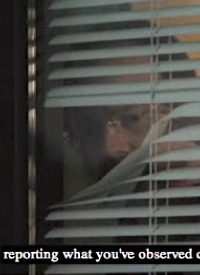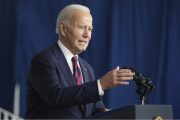
The Department of Homeland Security has announced it will be bringing it’s “If You See Something, Say Something™” campaign to hotel rooms across the nation. Guests checking in at reputable hotels like the Marriott and Hilton will be greeted by a message featuring Homeland Security Secretary Janet Napolitano immediately upon turning on their televisions.
According to the Department of Homeland Security, the “If You See Something, Say Something™” campaign was launched in July 2010, as a “simple and effective program to raise public awareness of indicators of terrorism and violent crime, and to emphasize the importance of reporting suspicious activity to the proper state and local law enforcement authorities.” It was launched in conjunction with the Nationwide Suspicious Activity Reporting Initiative (NSI) which is touted by the DHS as “an administration-wide effort to develop, evaluate, and implement common processes and policies for gathering, documenting, processing, analyzing, and sharing information about terrorism-related suspicious activities.”
It was first utilized by New York’s Metropolitan Transportation Authority (MTA), but will be reportedly expanding. UPI explains, “The Department of Homeland Security is turning to television and public service announcements to urge U.S. hotel guests to fight terrorism.” The same PSAs that will be aired in hotel rooms are already playing at hundreds of Wal-Marts across the country. They will now be expanded to 5,400 hotels that are serviced by television provider LodgeNet.
One 15-second spot is set at a train station, and features travelers alerting authorities about things like unattended bags and cab drivers placing a bomb in the trunk of his cab. The newest segment of the campaign will be aired in over a million rooms.
Another PSA is specifically oriented towards hotel employees and hotel guests, as it depicts a hotel patron paying for a room with cash. A voiceover indicates, “Not using a credit card to settle a hotel bill is ‘suspicious behavior.’ ”
Informing the “millions of guests that stay at hotels and motels each year is a significant step in engaging the full range of partners in our homeland security efforts,” Homeland Security Secretary Janet Napolitano explains.
The “See Something, Say Something” campaign has already been the subject of some fierce scrutiny for a variety of reasons.
First, it characterizes “suspicious behavior” as a large range of behaviors, including opposition to surveillance, using a video camera, talking to police officers, wearing hoodies, driving vans, writing on a piece of paper, and using a cell phone recording application.
According to Paul Joseph Watson, “Another primary indicator of suspicious activity is also being a white middle class American citizen, if the DHS promo clips are to be believed.” Analyzing the DHS promotional video for the “See Something, Say Something” campaign, Watson writes:
Almost all of the scenarios in the clip proceed to portray white people as the most likely terrorists. Bizarrely, nearly every single one of the “patriotic” Americans who reports on their fellow citizen is either black, Asian or Arab. Imagine if the video had portrayed every terrorist as an Arab and every patriotic snoop as white, there’d be an outcry and rightly so, but this strange reversal must have been deliberate on the part of the DHS, but why? Is this merely political correctness taken to the extreme or is something deeper at work?
Perhaps it has something to do with the fact that the DHS’ own internal documents list predominantly white conservative groups as the most likely terrorists, such as Rep. Ron Paul supporters, gun owners, gold bullion enthusiasts, and a myriad of other comparatively banal political interests that are largely the domain of white middle class Americans.
What’s worse is that the voiceover in the video states, “Reporting suspicious activity should not be based on a person’s race, religion or gender,” presumably explaining the reason for why 12 of the suspicious people in the video are white, and just three are minorities.
And even though 126 people of the people who were indicted on terrorist-related charges in the United States between 2009 and 2010 were Muslim, the video does not depict a single terrorist of Middle Eastern origin.
As Pajamas Media highlights, “The DHS video goes out of its way to avoid showing any terrorist who fits the profile of the actual terrorists who have been waging war on us for more than a decade: Young men primarily from the Middle East. Instead, it tends to show them as middle aged white men. And it doesn’t really show them doing much of what actual terrorists do. It’s as if DHS is trying to make a completely useless anti-terrorism video.”
Similar observations were made by the Drudge Report, Fox News, Breitbart.tv, and the Daily Mail, and were reportedly among the most read articles on the Internet during that 24 hour period. In fact, the version of the story featured on Fox Nation received well above 2000 comments.
Jihad Watch noted that if the situation was different, and every single terrorist in the video was either Arabic or a minority, and all of those dutiful Americans who reported them were white, there would be “Lawsuits. Oodles and oodles of lawsuits.”
The public outcry was so strong that the DHS was forced to issue a response. All they said was “the video is theirs but adamantly deny there are any racial or politically correct overtones to it.”
What is ironic about the racial overtones is that the DHS is adamant on its website against resting making any considerations for race when it comes to suspicious activity:
Factors such as race, ethnicity, national origin, or religious affiliation alone are not suspicious. For that reason, the public should report only suspicious behavior and situations (e.g., an unattended backpack in a public place or someone trying to break into a restricted area) rather than beliefs, thoughts, ideas, expressions, associations, or speech unrelated to terrorism or other criminal activity. Only reports that document behavior reasonably indicative of criminal activity related to terrorism will be shared with federal partners.
Overall, critics of the “See something, say something” campaign assert that programs such as this one do not lead to more secure societies, but instead “breed suspicion, distrust, fear and resentment amongst the population.”
Photo: Video from the DHS’s “If You See Something, Say Something™” Campaign seems to encourage paranoia and excessive suspicion.




